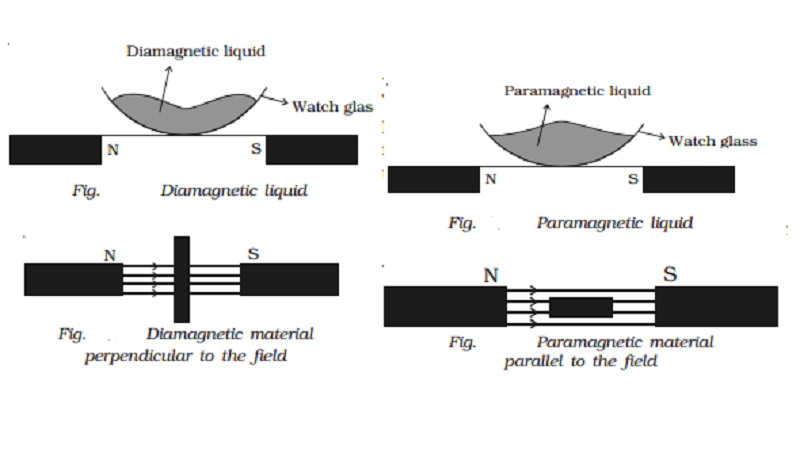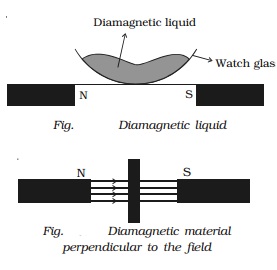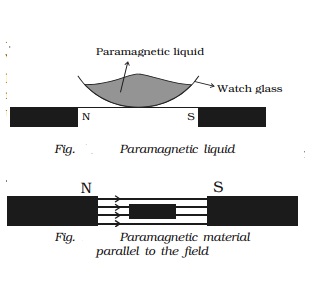Chapter: 11th 12th std standard Class Physics sciense Higher secondary school College Notes
Properties of diamagnetic, paramagnetic, ferromagnetic substances

Classification of magnetic materials
On the basis of
the behaviour of materials in a magnetising field, the materials are generally
classified into three categories namely,
(i) Diamagnetic, (ii)
Paramagnetic and (iii) Ferromagnetic
(i) Properties of diamagnetic
substances
Diamagnetic
substances are those in which the net magnetic moment of atoms is zero.
1.
The susceptibility has a low negative value. (For example, for
bismuth χm= ? 0.00017).
2. Susceptibility is independent of
temperature.
3. The relative permeability is
slightly less than one.
4. When placed in a non uniform magnetic
field they have a tendency to move. away from the field. (i.e) from the
stronger part to the weaker part of the field. They get magnetised in a
direction opposite to the field as shown in the Fig..
5. When suspended freely in a
uniform magnetic field, they set themselves perpendicular to the direction of
the magnetic field (Fig.).
Examples : Bi, Sb, Cu, Au, Hg, H2O,
H2 etc

(ii) Properties of paramagnetic
substances
Paramagnetic substances are those
in which each atom or molecule has a net non-zero magnetic moment of its own.
1. Susceptibility has a low positive
value. (For example : χm for aluminium is +0.00002).
2. Susceptibiltity is inversely
proportional to absolute temperature (i.e) χm α 1/T . As the temperature increases
susceptibility decreases.
3. The relative permeability is greater than one.
4. When placed in a non uniform magnetic field,
they have a tendency to move from weaker part to the stronger part of the
field. They get magnetised in the direction of the field as shown in Fig.
5. When suspended freely in a
uniform magnetic field, they set themselves parallel to the direction of
magnetic field (Fig.).
Examples : Al, Pt, Cr, O2,
Mn, CuSO4 etc.

(iii) Properties of ferromagnetic
substances
Ferromagnetic substances are
those in which each atom or molecule has a strong spontaneous net magnetic
moment. These substances exhibit strong paramagnetic properties.
1. The susceptibility and relative
permeability are very large. (For example : ?r for iron = 200,000)
2.
Susceptibility is inversely proportional to the absolute
temperature.
(i.e) χm α 1/T. As the temperature increases the value of
susceptibility
decreases. At a particular temperature, ferro magnetics become para magnetics. This transition temperature is
called curie temperature. For example
curie temperature of iron is about 1000 K.
3.
When suspended freely in uniform magnetic field, they set
themselves parallel to the direction of magnetic field.
4.
When placed in a non uniform magnetic field, they have a
tendency to move from the weaker part to the stronger part of the field. They
get strongly magnetised in the direction of the field.
Examples : Fe, Ni, Co and a
number of their alloys.
Related Topics